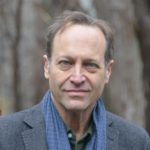
Why artist Sanford Biggers remixes different forms, styles of art to express himself
Transcript
Notice: Transcripts are machine and human generated and lightly edited for accuracy. They may contain errors.
Judy Woodruff: Sanford Biggers is an artist who mixes media and pushes boundaries to create an art all his own.
Jeffrey Brown looks at his interdisciplinary work, focusing on a signature work, Fool’s Folly, for our arts and culture series, Canvas.
Jeffrey Brown: On the walls, 20th century quilts that have become recognized as masterly works of art, on the floor, a new work using similar patterns but a different art form, a Buddhist sand mandala.
It’s literally made out of sand.
Sanford Biggers, Artist: It’s colored sand yes, unaffixed, placed on the floor.
Jeffrey Brown: Yes.
Sanford Biggers: We sneeze right now, this thing is gone.
(LAUGHTER)
Jeffrey Brown: There’s no sneezing, but plenty of riffing in Sanford Biggers’ work, now on exhibition at Washington, D.C.’s Phillips Collection. For an ongoing project the museum calls Intersections, he’s created a sculpture that plays off others already in the museum’s collection by artists such as Picasso and Giacometti.
But his marble bust is a hybrid figure, from the back, a classical Greek image of a woman, from the front, an ancestral African Chokwe mask.
Sanford Biggers: What I’m doing is putting those two together to created some type of conceptual dialogue. So I’m looking at this as the ancestors of modern aesthetics.
And we say the classical form and the non-classical form, but I think we’re past that. I would consider that a classical European form and a classical African form.
Jeffrey Brown: And what is it now, when you put them together?
Sanford Biggers: Now it’s contemporary art.
Jeffrey Brown: Biggers, now 51, finds and creates his art in many places, including with his experimental band, Moon Medicin, as much art happening as musical performance.
And he uses the language of contemporary music, like sampling in hip-hop, to describe his own approach to art-making from different traditions, what he calls material storytelling.
Sanford Biggers: So, how do you sample it, change it, distort it, put it back together, paste it with something else to create a new body of work?
I think objects are evocative. I think the object elicits certain memories and certain narratives, and when they’re juxtaposed with other objects, it creates more complicated narratives.
Jeffrey Brown: He did it in a large-scale, public way earlier this year with a series at New York’s Rockefeller Center, another remix using classical sculptures, which were themselves originally brightly painted.
And he does it in a more intimate way through his interest in textiles, especially antique quilts. A traveling exhibition titled Codeswitch is currently at the California African American Museum in Los Angeles.
Sanford Biggers: I started to paint and intervene on these antique quilts and started to consider it a sort of transgenerational, cross-generational communication.
Jeffrey Brown: It began with a theory that quilts had been used as signposts along the Underground Railroad to give coded instructions to escaping enslaved people. The theory was never conclusively proven, but Biggers loved the idea behind it.
Sanford Biggers: I thought, OK, what if these held codes? What would it mean for me then to come in 100 years or however many years later and add another layer of code to them?
So, in this sense, I am a late collaborator with the original makers of the quilt.
Jeffrey Brown: When it comes to the now famous quilts of Gee’s Bend, there is no painting on or reworking of, so the collaboration is of a different kind.
Woman: You have to have a mind made of the piece a quilt, because if you don’t have a mind made up of a piece of that quilt, it ain’t going to never go right.
Jeffrey Brown: In 2003, I had a chance to visit the small isolated Alabama community of Gee’s Bend, where several generations of women created quilts of extraordinary designs, shapes and colors, piecing together irregular strips of fabric.
The quilts drew comparison to modernist abstract paintings and were exhibited at New York’s Whitney Museum and around the country. One person who saw the quilts on exhibition back then was Sanford Biggers. Now the Phillips Collection, which owns five Gee’s Bend quilts, wanted Biggers to explore and address them through his own work.
Sanford Biggers: First thing I see is rhythm.
Jeffrey Brown: Movement through color and…
Sanford Biggers: Yes, there’s a retinal type of pacing that happens when you look at them, which are — is one of the hallmarks of a well-composed painting, is how the eye can move and dance around it. And these do that immediately.
Jeffrey Brown: Biggers constructed a three-dimensional quilt sculpture, and, having studied Buddhist culture in Japan, decided to find his rhythm in a mandala sand quilt’ painting.
He was helped by museum assistants trained in this unusual installation. Add it up, and it’s an endless kind of play, especially when you have all of art history to play with.
Sanford Biggers: I think that’s once again what artists do. The trick is to find your voice within that. But within the realm of possibilities, how do you find a voice and what are you saying with that voice?
Jeffrey Brown: And have you found it?
Sanford Biggers: I have multiple voices.
(LAUGHTER)
Sanford Biggers: I have a chorus.
Jeffrey Brown: Sanford Biggers’ Codeswitch exhibition is in Los Angeles until January 23 before moving to the Speed Museum in Louisville beginning mid-March. His Washington, D.C., work is on display through January 9.
For the “PBS NewsHour,” I’m Jeffrey Brown at the Phillips Collection.
Support Canvas
Sustain our coverage of culture, arts and literature.

















